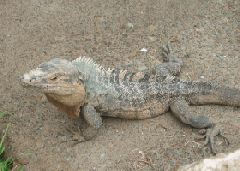Costa Rica's threatened fauna







Costa Rica counts some 820 resident and neotropical migrant bird species, 205 different mammals (half of them bats), some 400 reptile and amphibian species and 560 species of butterflies. There are about 10,000 higher plants, including 1200 orchids.
In 2017, the Ministry of Environment MINAE published updated lists of Fauna in Danger of Extinction (46 bird species - previously 17, 21 mammals - previously 13, 13 reptiles - previously 10, and 44 amfibians, Fauna with Reduced or Threatened Populations (74 bird species - previously 85, 44 mammals - prevously 15, 12 reptiles and 24 amfibians - previously together 109, and Flora in Danger of Extinction and Flora with Reduced or Threathened Populations.
With the publication of the new Regulation Decree No. 32633 of 2005 of the 1992 Law for the Conservation of Wildlife, the lists had already replaced the first versions of 1997.
One of the well known animals still heard and seen in many parts of the country but equally under threat today, is the Howler Monkey (mono congo). Over the 12 years between 1994 and 2006, populations of the four most common monkey species in Costa Rica have decreased on average by 50% (Conference on Costa Rica's Primates, San Ramon, 2006), the numbers of the Spider Monkey (mono colorado), a species threatened with extinction, have dropped from 25,000 to just 7,000. Squirrel Monkeys (saimiri sciureus) and Capuchin Monkeys (cebus apella) declined with 43%. Worldwide, more than one quarter of the aprox. 400 monkey species is threatened with extinction. In Costa Rica, reasons for the decline of monkey populations are the use of chemicals and pesticides in banana and pineapple plantations, the fragmentation of their habitat due to deforestation and development for tourist projects, poor health of the animals caused by lack of suitable food available, hunting, electrification at power lines, etc.
As with the problems of deforestation, also here applies that the existing legislation does not offer Costa Rica's fauna sufficient protection. Until recently, the Law for the Conservation of Wildlife permitted hunting for pleasure, also on species whose habitat has been severly reduced, and penalties for keeping protected animals or birds as pets were insufficient. It is estimated that some 300,000 costaricans keep a wild animal in captivity. Fortunately, with the initiative by Apreflofas (www.apreflofas.or.cr) the law has been changed and in 2012 Costa Rica became the first country in the world to prohibit hunting for pleasure.






